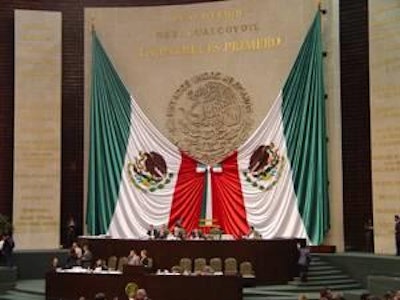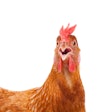
Before the signing of the North American Free Trade Agreement between Mexico, the United States and Canada, there was talk of catastrophic negative impacts on various industries in Mexico, a little reality, but also a bit of pessimism and low self-esteem. The impact of NAFTA on the Mexican poultry industry is explored from the legislative point of view in the Mexican House of Representatives, to the producers point of view in the National Poultry Producers Association (Unión Nacional de Avicultores, UNA) and the National Feed Manufacturers Council (Consejo Nacional de Fabricantes de Alimentos Balanceados, CONAFAB).
A mature and strong poultry sector
Sergio Chávez, chief executive officer of UNA, tells us that in Mexico "when it comes to poultry, we are talking about a sector that has gained much ground in terms of maturity. It has a business vision; decisions are taken and are based on the economic and financial parts of what happens in Mexico and the world. These are companies that reinvest in improving, integrating, in processes that give them greater productivity and efficiency per bird or per kilo of eggs produced. In this I think it is a long way from other livestock sectors."
"I believe that the growth of the poultry industry is evident. For example, the state of Jalisco currently leads the nation in egg production, has a significant growth and of course we are doing what is appropriate, trying to invest and keep going for the industry", says Mr. Maurilio Ochoa, egg producer in the state of Chihuahua and house representative of his state (of the PRI party).
Positive impact
The poultry industry has benefited. For example, under NAFTA, the government was obliged to remove the price controls for eggs and remove import licenses for sorghum. It has not done this for corn, because corn is linked to the tortilla, the staple food in Mexico. They began working with import quotas and tariffs were eliminated immediately for machinery and equipment.
Since 1994, production and per capita consumption have nearly doubled. Domestic competition within the poultry industry has led to a more consolidated industry, but the remaining companies can compete on an international stage.
Tariff relief scheme
The tariff relief period lasted 10 years, of which four were through the GATT, a scheme that worked. "There's where the poultry industry, through UNA, managed to have a clear picture about what would happen in time and was increasingly professionalizing the business relationship with the US," says Chávez. "The Mexican poultry industry was among the few sectors that managed to have a seat in the import quotas committees, not only of corn but also of equipment, birds, fertile eggs, oilseeds and meat, for that relief period."
"Obviously, at that time we did not have the experience and knowledge we have now. Had we had it, maybe we would have removed leg quarter imports from the negotiations in order to have a more even field," Chávez recalls.
Since the inception of NAFTA, tariffs for sorghum imports were removed. In oilseeds, the oil industry achieved a 10-year tariff relief period. Corn continued with a high tariff, but 15 years after the signing it was removed. Since it had a general tariff, it was necessary to split it into yellow and white corn, so as to not "contaminate" the tortilla issue. The transition period gave the industry the opportunity to invest, expand, modernize, strengthen and balance.
Feeds
With respect to feed production, agreements have been good, too, because it fully opened imports of grains and oilseeds. "This has been great for our industry. In fact, there is not imported feed for production animals (although there is for pet foods)," says Fernando Aramburu, CEO of CONAFAB. Moreover, according to Javier León, CONAFAB's deputy director, "a major myth faded, the one that the grain producer would be one of the big losers. It really has not been that way: at the total leveling of corn in 2008, nothing really happened." Perhaps the high international grain prices have helped, since half of what this industry demands is bought here. "For us this is very useful because it's never good to have a single supplier, particularly of a commodity as important as grains." In this way there is a full coverage, which is an advantage.
Modernization of the poultry industry
An important aspect of NAFTA is that from the very beginning, there was opportunity to adopt state-of-the-art technologies, practically without paying tariffs on machinery and equipment. In many cases, this allowed for technology similar to what is used in Brazil, the U.S. or Europe. "In that sense, I think we are at the same level as any other country in the world", emphasizes Chávez.
"It is essential to go for an increased use of technology, to consider a more efficient production in terms of costs, taking advantage of the proximity with the US," says Mr. Ochoa. The levels of technology in the industry are extremely important, "but technology is not just to have automated equipment, I believe that an increased use of technology has to go beyond that, to offer the consumer products such as Salmonella-free pasteurized egg, or liquid eggs", added Mr. Ochoa. "As we move forward and give it added value to the product, we will generate a stronger industry."
Aligning internal and external policies
When asked if the Mexican government has managed to align internal and external policies to assist domestic producers to be competitive at an international level, Cruz López, house representative of the state of Tamaulipas (of the PRI party), tells us that "in the NAFTA and other trade agreements Mexico has already signed, there was no protection like other countries (e.g., Canada took out of the negotiation milk and milk products); we did not even take out the most sensitive items in terms of feeding the people of Mexico, such as white corn and beans."
Exports
The issue of free trade agreements has always been the domestic Mexican market, because Mexico still does not stand out for its exports. In fact, "Mexico is late in starting its export program," Chávez explains, compared with Brazil, Argentina or Chile, countries that have advantages both in programs and in export volumes. We need to develop public policies aimed at the Mexican poultry industry so as to begin to supply the export market with chicken meat. However, something has already been done with eggs.
In order to have a healthy industry in the long run, with a stronger base and so to excel, export markets need to start. We must seize the pace of growth since NAFTA began, with all its ups and downs. "Just as Brazil, Argentina and Chile does, by producing an additional amount to what is demanded in the domestic market, dedicated to export markets," Chávez points out.
A public policy that helps the industry to have this opportunity must be looked for. Not to seek compensations per slaughtered bird or resources to build a plant. This is a mature industry, because it invests. "We need support from the Mexican government to ensure competitiveness," emphasizes Chávez. "Ideally, at least set a goal in the next 5 years to export 10% from the total eggs and chickens produced."
A one-way or a two-way trade?
"An unfinished business issue is precisely that to date, we have been unable to access the U.S. market," Chávez began when referring to this topic. Trade on both sides of the border has not been achieved with chicken, in which the most important issue is the difference between leg quarter and breast. There have been some sporadic exports of fresh eggs. However, success has been achieved with processed eggs, not so much with the U.S., but with other FTAs such as with Japan, the EU, and also with countries in Africa with which we do not have agreements, exporting spent layers, fresh shelled eggs and egg products, as well as with Asian countries.
In the case of feed, Aramburu says that "we can not export, mainly due to production costs compared with the US, plus the transportation cost; it is an almost impossible market for feed." However, "we have got by quite well from U.S. producers, based on price and quality. Although we are net importers of grains and oilseeds, the price of the Mexican feed is still better than the imported one."
Conclusions
For the Mexican poultry industry, free trade has led to a more competitive industry and led the way for expansion. The acquisition of U.S. broiler producer OK Foods by the Bachoco Foods of Mexico is just one example of the competitiveness of Mexican poultry companies in this new era of free trade. Development of export markets, the production of value-added products, and investments abroad will keep the Mexican poultry industry growing, modernizing and creating jobs.
We appreciate the assistance in the House of Representatives of Mr. Héctor Velasco, representative (of the PRI) of the LXI Legislature.


















